Contemporary Church History Quarterly
Volume 19, Number 1 (March 2013)
Franz Stock and the “Barbed-Wire Seminary” at Le Coudray, France*
By Lauren N. Faulkner, University of Notre Dame
“Abbé Franz Stock – that is no name, it is a program!”[1]
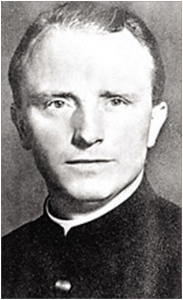
Franz Stock. Source: H. Briand and Les Amis de Franz Stock; used with permission.
Franz Stock died alone in a Parisian hospital in February 1948, not yet forty-four years old. Born in Neheim (now part of the city of Arnsberg) in Rhineland-Westphalia in 1904, he had spent most of his adult life in France, working as a priest, a prison chaplain and, beginning in 1945, the director of a “barbed-wire seminary” in a French POW camp for German soldiers wanting to become priests. He was an ardent Catholic and a devout Francophile. His story, in particular his contributions to Franco-German rapprochement after 1945, remains relatively separate from mainstream historiography, with only one recently-published account in English.[2] Those who know of him on both sides of the Franco-German border insist that no complete account of postwar rapprochement, and the laying of the groundwork for the European Union itself, can be proffered without acknowledging Stock’s vital role. Who exactly was this priest, then?
Boniface Hanley’s 2010 biography is more hagiographic than academic, but it contains a helpful account of Stock’s family life and spiritual influences, and Stock’s significance as a German in France during the Nazi occupation and the first few years of the post-occupation period. Hanley conducted interviews with individuals who had known Stock personally, or did extensive research on him; his book is the culmination of several decades of work. Stock was the oldest of nine children born to a working-class couple, and he knew by the time he was twelve years old that he wanted to become a priest. He attended the seminary at Paderborn and joined the Quickborn (Catholic youth) movement, with which he was first able to visit France during the summer of 1926, for an international peace conference held at Bierville. He was deeply influenced by the example of Marc Sangnier, a militant French Catholic pacifist who was in favor of progressive reform for the Church, who had organized the conference. As a result of this love affair with France, Stock applied to spend three semesters at the Institut Catholique in Paris; he was the first German to be admitted since the Middle Ages. It was during this impressionable stage of his life, Hanley writes, that Stock became determined to dedicate his life Franco-German reconciliation, a devotion all the more extraordinary for the reality Stock faced when he gave himself over to it: this was arguably the most intensely hostile period of the two countries in their centuries-long history of rivalry, enmity, and bloodshed.
Stock was ordained a priest in 1932, and two years later was appointed to run the Boniface Mission, Paris’ German Catholic center, in the Latin Quarter of the French capital. However, it is between the 1940 fall of France to Nazi Germany and the final months of 1947 that Stock’s life would find its fullest meaning. His arrival back in Germany upon the outbreak of the Second World War was only temporary; he applied for and received permission to return to Paris in June 1940. Eventually he procured from the German ambassador to Vichy France a pass allowing him to visit imprisoned Frenchmen and women, to give them pastoral care. Subsequently he was given the title of auxiliary Wehrmacht chaplain, with the honorary rank of Major, and assigned to tend the souls in the prisons of Fresnes, La Santé and Cherche-Midi, all of the Wehrmacht prisons in the greater Paris area (used to hold German soldiers charged with breaches of discipline), and La Pitié Hospital. He also retained his position as director of the Boniface Mission. With the exception of two relatively brief periods when he had junior chaplains assisting him, Stock was the sole provider of pastoral care for three of France’s largest prisons, a hospital, a myriad of smaller prisons, and his own church. As part of his pastoral duties, he accompanied hundreds of prisoners, mostly members of the French Résistance, to their execution site at the infamous Mont Valérien between 1940 and 1944.[3] During the occupation of France, he also served as a clandestine intermediary between the prisoners and their families, and often was the only link through which they could communicate with each other.
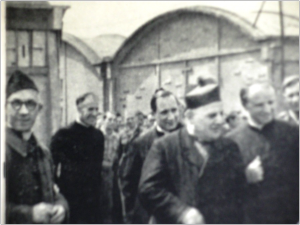
The religious figures involved in getting the “barbed wire seminary” off the ground. From left to right: Georges Le Meur; Wilhelm Delbeck, Stock’s main assistant at the seminary; Jean Rodhain (?); Angelo Roncalli, Vatican nuncio to France; Franz Stock. Source: H. Briand and Les Amis de Franz Stock; used with permission.
This remarkable individual, and his equally remarkable life, are remembered less for the inestimable services he performed as a chaplain during the Occupation, and more for the responsibility he took on at the end of the war, when he was already physically and emotionally fatigued. In the winter of 1944/45, after France had been liberated from Axis control, Abbé Jean Rodhain, French chaplain-general in charge of all German and Axis POWs, took note of the presence of young prisoners in various POW camps across the country who had been studying in seminaries before being conscripted into the Wehrmacht. Together with his assistant Georges Le Meur, another priest who had been active in the Résistance, Rodhain received permission from the military authorities to organize a temporary seminary in one camp and began to search for volunteer attendees from among the POW population. They did so in the interests of revitalizing the Catholic Church in Germany, in the hopes that the Church would play a role in the reconstruction – and re-Christianization – of Germany after the fall of Nazism. Rodhain and Le Meur did not hesitate to choose a German priest to head the seminary. It was Le Meur who nominated Stock for the position. Stock was himself a POW at a camp near Cherbourg; despite his physical illness, he readily assented to his new position.

Plan of Block 1, the “barbed wire seminary” at Le Coudray. The main barrack, housing the dormitory, refectory, and chapel, is at the bottom. Source: H. Briand and Les Amis de Franz Stock; used with permission.
What began as an experiment with a few seminarians near the POW camp at Orléans became by Christmas 1945 an impressive, smoothly-running operation at Le Coudray, on the outskirts of Chartres, with more than 380 enrolled seminarians. The seminary was moved after encountering increasingly severe problems with the other German POWs at Orléans. The camp’s military commander and supporter of the seminary project, Laurent Gourut, was transferred to Le Coudray and arranged for the seminary to go with him. In addition to the seminarians, the project also involved forty lay brothers (also culled from the German POW population in France) who served as cooks and cleaners, Chartres’ bishop, Monsignor Thomas Harscouet, who knew of and approved of what was going on, and the Vatican’s nuncio in France, Angelo Roncalli, who gave his blessing to the camp in person. In 1946, Stock added several volunteer faculty members from the University of Freiburg, who came of their own free will – and became POWs as a result – to teach courses on moral theology, pastoral theology, canon law, scripture, and others. In the two years that the “barbed wire seminary” (French: séminaire de barbelés; German: Stacheldrahtseminar) existed, more than 1,000 Germans benefitted from its courses, and more than 600 of these went on to be ordained priests.[4]
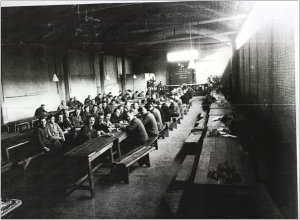
The refectory of the “barbed wire seminary.” Source: H. Briand and Les Amis de Franz Stock; used with permission.
What is even more astonishing was the secrecy that remained relatively intact around the entire affair: few ministers in the de Gaulle provisional government knew of the seminary (excepting Michelet and Boisseau, director-general of prisoners of war in France) because Rodhain and Le Meur feared the reaction of the communists if they learned of what was going on. The majority of the French ecclesiastical hierarchy who knew of the seminary did not approve, but kept silent about its existence. And finally, the inhabitants of Chartres did not know much, either of the seminary or of the camp itself. Consumed with the business of surviving in the post-war chaos, few interested themselves in the detested German POWs languishing indefinitely behind barbed wire on the outskirts of their city.
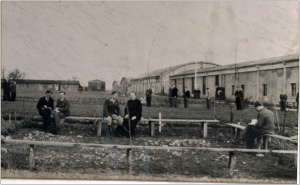
Taking in the air outside the barracks. Franz Stock is the priest seated in the middle of the picture. Source: H. Briand and Les Amis de Franz Stock; used with permission.
The camp’s remaining seminarian internees were liberated on 1 May 1947, shortly after they had completed their final examinations. Le Coudray was shut down in December of that year. During the summer, Stock returned to Paris, a paroled POW whose could not even obtain an identity card that would have allowed him to leave Paris for short periods of time. He began to reorganize the Boniface Mission in the Latin Quarter and helped whoever came to his door, which included both French and German priests but mostly former German POWs (now called “free workers”) unable or unwilling to make the journey back to a devastated Germany.[5] On 22 February 1948, he collapsed and was hospitalized, diagnosed with pulmonary edema. He died two days later. Because of his POW status, he was not permitted a public funeral, nor was his family allowed to make the journey from Neheim to attend. Still, some one hundred people appeared for the private service that his friends had organized. Those who attended included Abbé Rodhain, Angelo Roncalli as nuncio, the auxiliary bishop of Paris, and government ministers Michelet and Francisque Gay. He was buried in a simple grave marked only with an unpainted wooden cross in Paris’s large Thiais cemetery.[6]
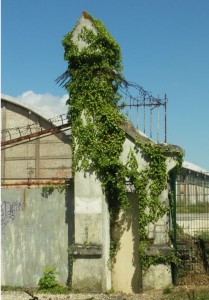
One side of the original gate to the camp, Depot #501, Le Coudray, France. Source: H. Briand and Les Amis de Franz Stock; used with permission.
Today the camp at Le Coudray still stands, but is much diminished. Originally occupying thirty-two hectares and known as POW Depot #501, today the camp is just under eight hectares (the size of the original camp, first opened in 1912). The Franz Stock Committee, in its French and German manifestations, Les Amis de Franz Stock and Franz-Stock-Komitee, is dedicated to preserving the site, renamed the Franz Stock European Meeting Center (Centre Européen de Rencontre Franz Stock; Europäische Begegnungsstätte Frankz Stock). It is composed of a single preserved barrack, which housed the main building of the seminary and its chapel, and the land immediately around it. The rest of the site and the half-dozen or so remaining barracks are owned by various local collectivities. The military has not been associated with the site since 2001.
Much of the association’s successes have come only in the last two decades. In March 1998, Chancellor Helmut Kohl of Germany visited Chartres and the former POW camp to honor Stock on the fiftieth anniversary of his death. It was only in June 2005 that the association succeeded in securing the buildings as historical monuments. In February 2008, French President Nicolas Sarkozy marked the sixtieth anniversary of Stock’s death with a ceremony at Mont Valérien, where he had accompanied so many Résistance prisoners to be executed; the plaza in front of the memorial set up there had been renamed after Stock in 1990. In November 2009, the process of beatification was opened for Stock in his birthplace in Neheim, and is currently ongoing.[7]
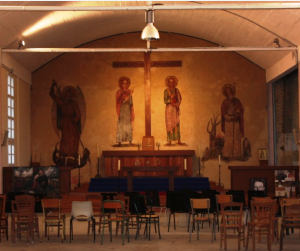
The interior of the seminary chapel today, complete with Stock’s original (restored) murals. Saint Michael slaying the dragon on the left, Saint Boniface on the right. Both are patron saints of Germany. Source: Lauren N. Faulkner; used with permission.
Source: Lauren N. Faulkner; used with permission.
Most of the exhibitions about Franz Stock and the seminary are set up in the barrack that once served as the refectory, sleeping hall, and chapel. Since it is unheated, one gets a sense if one visits in late January of how brutally cold the seminarians’ lives must have been in the winters of 1945/46 and 1946/47, and also of how intimate, since dozens of men would have been crowded against each other. The chapel has received the most concerted restoration efforts thus far; Stock’s murals on the wall behind the altar have been repainted recently, and some of the original Stations of the Cross, also painted by Stock, have been returned. It is still used for masses on special occasions, and the site receives a healthy does of visitors annually, mostly schoolchildren of various ages from France, Germany, Switzerland, and Austria, but also Catholics who have heard of Stock.

Stock’s own paintings of The Stations of the Cross graced the seminary chapel. Station 12, the death of Christ on the cross. Source: H. Briand and Les Amis de Franz Stock; used with permission.
It is difficult to argue convincingly that Stock had a direct impact on postwar Franco-German rapprochement; there is no evidence that draws a straight line from him to de Gaulle and Adenauer in 1963, and during his lifetime there was no interest in French political circles to extend to Germans the hand of friendship. But this misses the true impact of Stock’s life and work. He was a quiet, behind-the-scenes worker, proving by his own example rather than through force of words that French and Germans could co-exist peacefully, even amicably. This devotion produced a trickle-down effect, demonstrating to the French families who suffered the execution of loved ones during the occupation that not all Germans were evil, and to the German POWs in French camps after the war, many of whom went on to become priests in post-war Germany, that not all Frenchmen were focused on revenge against Germany. It is more than seventy years now since France and Germany were at war with each other. Stock may have been out of step with his time, as a German who loved the French and wished to live among them, but this failed to daunt him. It is time that his life and his influence were introduced to a wider audience.
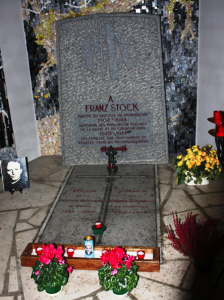
Stock’s shrine and grave at St. Jean-Baptiste Rechèvres Church, in Chartres. The inscription on the headstone reads:
To Franz Stock
Priest of the diocese of Paderborn
1904-1948
Chaplain of the prisons of Fresnes
La Santé and Cherche-Midi
1940-1944
The families of the French prisoners and executed are appreciative
The inscription on the ground reads on the left: Rector of the German parish of Paris 1934-1944; on the right: Superior of the barbed-wire seminary of Chartres 1945-1947
Source: Lauren N. Faulkner; used with permission.
* The author would like to thank Monsieur Hubert Briand, of Les Amis de Franz Stock, for his time and patience in introducing the camp and answering all manner of questions about Franz Stock, German POW seminarians, and Chartres, and for his permission to use several camp photos.
[1] Angelo Roncalli, the future Pope John XXIII, at a private funeral service after Stock’s death, 28 February 1948. At the time he was nuncio to France.
[2] This report is based on Boniface Hanley, The Last Human Face: Franz Stock: A Priest in Hitler’s Army (self-published, 2010), and on the author’s visit to Chartres in January 2013. This was a preliminary research trip to gather information for a future book-length project on the barbed-wire seminary at Le Coudray and the French treatment of German POWs between 1945 and 1948.
[3] Mont Valérien is a small rise in Suresnes, a western suburb of Paris. Before the Nazi occupation of France, it had part of the city’s fortifications. The Nazis used it almost exclusively as an execution site. More than 1,000 Frenchmen were executed there between 1940 and 1944 (French law, which the occupiers observed in this instance, prohibited the execution of women by firing squad, so there were no women victims). Stock’s wartime diary, which he used to record his daily ministrations for the condemned prisoners, and which Hanley indicates he kept quite faithfully, mentions 863 of these victims, the majority by name.
[4] The author is still researching information about what kinds of courses were offered, by whom they were taught, how long they were, and of what the examinations consisted. All information at the time of writing indicates that the exams were recognized in Germany, and presumably the Vatican, because the seminarians did not have to repeat these courses after their release.
[5] It is not clear how long after the war the Boniface Mission in Paris remained open for Germans, or how it was funded. Today there is a small plaque on the wall of the building at 21-23 Rue Lhomond identifying it as the former home of Franz Stock. It appears now to be a private residence.
[6] After a concerted effort led by former barbed-wire seminarians, Stock’s remains were exhumed and transferred in June 1963 to a small shrine built for the purpose in the new St Jean-Baptiste church, just outside the city of Chartres, in Rechèvres. Six months earlier, Charles de Gaulle of France and Konrad Adenauer of West Germany had signed the Treaty of Élysée, more commonly known as the Friendship Treaty. It formally ended centuries of hostility between the two countries. Stock’s tomb at Rechèvres draws many visitors, but his empty grave at Thiais is still honored with a plaque, and often with flowers.
[7] Neheim is also home to the Franz Stock Museum in the Fresekenhof, a former aristocratic dwelling dating to the fourteenth century, which contains a permanent exhibition dedicated to Stock’s life and works. Documentation about Franz Stock is also housed at the National Archives in College Park, Md., and a more limited amount in Germany, at the National Military Archives in Freiburg im Breisgau and the Catholic Military Bishop’s Office in Berlin. The author has yet to see Stock’s diary, which she believes is in Neheim.

Lauren! Great article! Inspiring as well as informational. Very happy to see you out there in the academic world. John Conway, the founder of this journal, was my history prof at UBC a thousand years ago. Please call me the next time you are in Vancouver and let’s catch up.
Best as always,
Don
Thank you for this fine article. I write about Stock and the Stacheldrahtseminar in PONTIFFS: POPE WHO SHAPED HISTORY (Our Sunday Visitor 1994) pp. 247f.
In 1946/47 I was a seminarist in the seminary of barbed wire in Chartres and I have been living since 1960 in the home town Neheim of Franz Stock. I wrote the book “Abbé Franz Stock. Kein Name – ein Programm” Bonifatius-Verlag Paderborn and the brochure “Frieden als Auftrag. Das lebenswswerk des Preisters Abbé Franz Stock. I prepared and built up the exhibiton of Stock’s life in the Fresekenhof at Naheim.
Since 1964 I have been a member of the Franz-Stock-Comittee and have been for some time Vice-President.
If you nee more indormation, please contact me with my e-mail-address
best wishes
Dieter lanz
Das sogenannte Tagebuch (Diary) befindet sich im Archiv des Erzbistums Paderborn (Archdiocese of Paderborn). Das Franz-Stock-Komitee besitzt eine Abschrift:
http://www.franz-stock.org/index.php?option=com_content&view=article&id=75&Itemid=116&lang=de
Thank you to the readers above who took the time to comment on my article. Franz Stock is easily the most extraordinary individual I’ve been privileged to study, and I’m happy to share this with you!
How wonderful and beautful. It let me near tears.
Dear Ms. Faulkner,
I recently learnt of your article about Franz Stock and the “Barbed Wire Seminary”.
As I once wrote an article on Stock´s visit of French prisoners in our local jail in Rheinbach near Bonn on January 11th, 1943, I am somewhat familiar with the literature on Stock. I know Le Mont Valerien, Chartes and Le Coudray and also M. Mercier there.
The reason I am writing to you lies in the book by F. Hanley, OFM. To put it bluntly: I wish that book had never been written. It is full of mistakes and dreamt-up events.
I was able to contact Hanley shortly before his death and ask him about his sources in one case. He could only cite abother book against which Erich Kock, who had been a student of Stock, warned me as partly unreliable.
Your fields of interest mostly agree with mine and I would be delighted if we could exchange our views.
Sincerely,
Dr.Gerhard Düsterhaus
Studiendirektor i.H. (ret.) at the English and American Department of Bonn University/Germany.
Dear Ms. Faulkner,
I am trying to send you a letter with more detailed comments on your article either by e-mail or by regular mail.
Sincerely,
G.Düsterhaus
Dear Prof. Faulkner,
just something we would like you to be aware of. The video about Franz Stock produced by Hans Peylo and callable on the official website of the Franz Stock Komitee is now also available in an English version (select the respective language).
The direct link is:
http://www.franz-stock.org/index.php?option=com_content&view=article&id=645&Itemid=319&lang=en
Please feel free to share with us any comments you might have.
Sincerely,
Meinolf Schwens
on behalf of Franz- Stock- Komitee für Deutschland e.V.